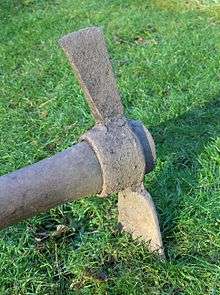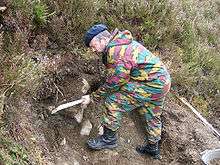Mattock
 A cutter mattock, embedded in a lawn | |
| Classification | Digging tool |
|---|---|
| Related | Pickaxe |
A mattock /ˈmætək/ is a versatile hand tool, used for digging and chopping, similar to the pickaxe. It has a long handle, and a stout head, which combines an axe blade and an adze (cutter mattock) or a pick and an adze (pick mattock). A cutter mattock is similar to a Pulaski.
Description
A mattock has a shaft, typically made of wood, which is about 3–4 ft (0.9–1.2 m) long.[1] The head consists of two ends, opposite each other and separated by a central eye. A mattock head typically weighs 3–7 lb (1.4–3.2 kg).[1] The form of the head determines the kind and uses of the mattock:[2]
- A cutter mattock has a head that combines an axe and adze. Thus, it has two flat blades that are opposite of each other, with one blade rotated 90° relative to the other. The axe blade is designed for cutting roots.[2]
- A pick mattock has a head that combines a pick and adze. The pick is rarely sharpened and the adze is sometimes sharpened.[2] This is "one of the best tools for grubbing in hard soils and rocky terrain".[2]
In the eastern United States, the shafts of mattocks are often fitted with a screw below the head and parallel with it to secure the head from slipping down the shaft, but in the western United States, where tools are more commonly dismantled for transport, this is rarely done.[2] When made to be dismantled, the shaft of a mattock fits into the oval eye of the head, and is fixed by striking the head end of the shaft against a solid surface, such as a tree stump, rock, or firm ground. The head end of the shaft is tapered outwards, and the oval opening of the iron head is similarly tapered so that the head will not fly off when used. The mattock head ought never be raised higher than the user's hands, so that it will not slide down and hit the user's hands. The mattock is meant for swinging between the user's legs, as in digging a ditch with one foot on either side. Tapping the handle end of the shaft while holding the head allows the handle to slide down and be removed.[2]
Uses

Mattocks are "the most versatile of hand-planting tools".[3] They can be used to chop into the ground with the adze and pull the soil towards the user, opening a slit to plant into.[3] They can also be used to dig holes for planting into, and are particularly useful where there is a thick layer of matted sod.[3] The use of a mattock can be tiring because of the effort needed to drive the blade into the ground, and the amount of bending and stooping involved.[3]
The adze of a mattock is useful for digging or hoeing, especially in hard soil.[1]
Cutter mattocks (Swahili: jembe-shoka) are used in rural Africa for removing stumps from fields, including unwanted banana suckers.[4]
The mattock was most likely the main murder weapon when six people were killed in the brutal murders in Hinterkaifeck.
History
As a simple but effective tool, mattocks have a long history. Their shape was already established by the Bronze Age in Asia Minor and ancient Greece.[5] According to Sumerian mythology, the mattock was invented by the god Enlil.[6] Mattocks (Greek: μάκελλα) are the most commonly depicted tool in Byzantine manuscripts of Hesiod's Works and Days.[7]
Mattocks made from antlers first appear in the British Isles in the Late Mesolithic. They were probably used chiefly for digging, and may have been related to the rise of agriculture.[8] Mattocks made of whalebone were used for tasks including flensing – stripping blubber from the carcass of a whale – by the broch people of Scotland and by the Inuit.[9]
Etymology
| Look up mattock in Wiktionary, the free dictionary. |
The word mattock is of unclear origin; one theory traces it from Proto-Germanic, from Proto-Indo-European (see Wiktionary). There are no clear cognates in other Germanic languages, and similar words in various Celtic languages are borrowings from the English (e.g. Welsh: matog, Irish: matóg, Scottish Gaelic: màdog).[10] However, there are proposed cognates in Old High German and Middle High German, and more speculatively with words in Balto-Slavic languages, including Old Church Slavonic motyga and Lithuanian matikas,[10] and even Sanskrit. It may be cognate to or derived from the unattested Vulgar Latin matteūca, meaning club or cudgel. The New English Dictionary of 1906 interpreted mattock as a diminutive, but there is no root to derive it from, and no semantic reason for the diminutive formation.[10] Forms such as mathooke, motthook and mathook were produced by folk etymology. Although used to prepare whale blubber, which the Inuit call "mattaq", no such connection is known.
While the noun "mattock" is attested from Old English onwards, the transitive verb "to mattock" or "to mattock up" first appeared in the mid-17th century.[10]
See also
| Wikimedia Commons has media related to Mattocks. |
References
- 1 2 3 Cathy Cromell (2010). "Tools of the Trade". Composting For Dummies. For Dummies. pp. 15–28. ISBN 978-0-470-58161-2.
- 1 2 3 4 5 6 Robert C. Birkby (2006). "Tools". Lightly on the Land: the SCA Trail-building and Maintenance Manual (2nd ed.). The Mountaineers Books. pp. 75–102. ISBN 978-0-89886-848-7.
- 1 2 3 4 Robert D. Wray (2009). "The planting job". Christmas Trees for Pleasure and Profit (4th ed.). Rutgers University Press. pp. 75–92. ISBN 978-0-8135-4417-5.
- ↑ Björn Mothander, Finn Kjærby & Kjell J. Havnevik (1989). "Types of farm implements used in Tanzania". Farm Implements for Small-scale Farmers in Tanzania. Nordic Africa Institute. pp. 22–72. ISBN 978-91-7106-290-1.
- ↑ Isabelle Kelly Raubitschek (1998). "Tools". The Metal Objects (1952-1989). Volume 7 of Isthmia: Excavations by the University of Chicago, Under the Auspices of the American School of Classical Studies at Athens. American School of Classical Studies at Athens. pp. 119–130. ISBN 978-0-87661-937-7.
- ↑ Hooke, S. H. (2004). Middle Eastern Mythology. Dover Publications. ISBN 978-0486435510.
- ↑ Frederick M. Hocker (2004). "Tools". In George Fletcher Bass & James W. Allan. Serçe Limani: an Eleventh-century Shipwreck, Volume 2. Volume 4 of The Nautical archaeology series. Texas A&M University Press. pp. 297–328. ISBN 978-0-89096-947-2.
- ↑ I. J. Thorpe (1996). "The introduction of farming to Britain and Ireland". The Origins of Agriculture in Europe. Material Cultures Series. Routledge. pp. 94–118. ISBN 978-0-415-08009-5.
- ↑ Vicki Ellen Szabo (1997). "The use of whales in early Medieval Britain". In C. P. Lewis. Studies in Medieval History. Volume 9 of The Haskins Society Journal. Boydell Press. pp. 137–158. ISBN 978-0-85115-831-0.
- 1 2 3 4 "Mattock". Oxford English Dictionary (3rd ed.). Oxford University Press. September 2005. (Subscription or UK public library membership required.)